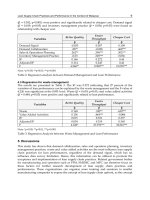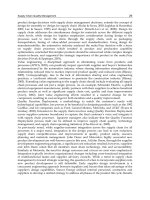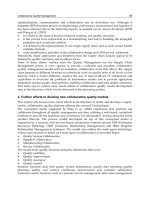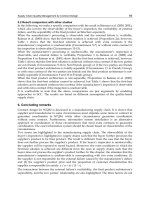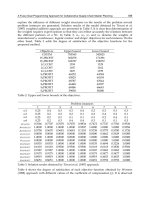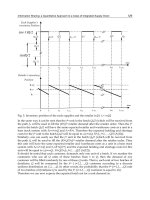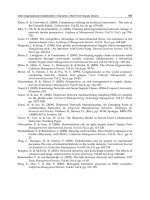Supply Chain Management Pathways for Research and Practice Part 10 pot
Bạn đang xem bản rút gọn của tài liệu. Xem và tải ngay bản đầy đủ của tài liệu tại đây (785.4 KB, 20 trang )
Inter-Organizational Collaboration in Dynamic, Short-Term Supply Chains
169
Katzy, B. & Crowston, K. (2008). Competency rallying for technical innovation - The case of
the Virtuelle Fabrik. Technovation, Vol.28, No.10, pp. 679-692.
Kim, T., Oh, H. & Swaminathan, A. (2006). Framing interorganizational network change: A
network inertia perspective. Academy of Management Review, Vol.31, No.3, pp. 704-
720.
Lavie, D. (2006). The competitive advantage of interconnected firms: An extension of the
resource-based view, Academy of Management Review, Vol.31, No.3, pp. 638-658.
Magretta, J. & Fung, V. (1998). Fast, global, and entrepreneurial: Supply chain management,
Hong Kong style - An interview with Victor Fung. Harvard Business Review, Vol.76,
No.5, pp. 102-114.
Maon, F., Lindgreen, A. & Vanhamme, F. (2009). Developing supply chains in disaster relief
operations through cross-sector socially oriented collaborations: a theoretical
model. Supply Chain Management-an International Journal, Vol.14, No.2, pp. 149-164.
Miles, R., Miles, G., Snow, C., Blomqvist, K. & Rocha, H. (2009). The I-Form Organization.
California Management Review, Vol.51, No.4, pp. 59-76.
Minor, M. S., Patrick, J. M. & Wu, W Y. (1995). Conglomerates in the world economy:
comparing keiretsu, chaebol and grupos. Cross Cultural Management: An
International Journal, Vol.2, No.4, pp. 35-45.
Narasimhan, R. & Talluri, S. (2009). Perspectives on risk management in supply chains.
Journal of Operations Management, Vol.27, No.2, pp. 114-118.
Noori, H. (2009). Knowledge Network and Smart Supply Chains. Wilfrid Laurier University,
Waterloo, ON.
Noori, H. & Lee, W. (2006). Dispersed network manufacturing: adapting SMEs to compete
on the global scale. Journal of Manufacturing Technology Management, Vol.17, No.8,
pp. 1022-1041.
Noori, H. & Lee, W. (2009). Dispersed Network Manufacturing: An Emerging Form of
Collaboration Networks, In: Dispersed Manufacturing Networks: Challenges for
Research and Practice, Dekkers, R., Bennet, D., (Eds.), pp. 39-58, Springer, ISBN 978-
1-84882-467-6, London, UK
Noori, H., Tan, A. & Lee, W. (n.d.). The Shanzhai Model of Future-Proof Collaboration
Networks. Working Paper.
Oloruntoba, R. & Gray, R. (2006). Humanitarian aid: an agile supply chain? Supply Chain
Management-an International Journal, Vol.11, No.2, pp. 115-120.
Prashantham, S. & Birkinshaw, J. (2008). Dancing with Gorillas: How Small Companies Can
Partner Effectively with MNCs. California Management Review, Vol.51, No.1, pp. 6-
23.
Puig, F., Marques, H. & Ghauri, P. (2009). Globalization and its impact on operational
decisions The role of industrial districts in the textile industry. International Journal
of Operations & Production Management, Vol.29, No.7-8, pp. 692-719.
Reagans, R. & McEvily, B. (2003). Network structure and knowledge transfer: The effects of
cohesion and range. Administrative Science Quarterly, Vol.48, No.2, pp. 240-267.
Reinmoeller, P. & van Baardwijk, N. (2005). The link between diversity and resilience. MIT
Sloan Management Review, Vol.46, No.4, pp. 61-65.
Ring, P., Doz, Y. & Olk, P. (2005). Managing formation processes in R&D consortia.
California Management Review, Vol.47, No.4, pp. 137-155.
Supply Chain Management – Pathways for Research and Practice
170
Robertson, P. & Langlois, R. (1995). Innovation, Networks, and Vertical Integration. Research
Policy, Vol.24, No.4, pp. 543-562.
Saeed, K., Malhotra, M. & Grover, V. (2005). Examining the impact of interorganizational
systems on process efficiency and sourcing leverage in buyer-supplier dyads.
Decision Sciences, Vol.36, No.3, pp. 365-396.
Sanchez, A. M. & Perez, M. (2005). Supply chain flexibility and firm performance - A
conceptual model and empirical study in the automotive industry. International
Journal of Operations & Production Management, Vol.25, No.7-8, pp. 681-700.
Santos, J., Doz, Y. & Williamson, P. (2004). Is your innovation process global? MIT Sloan
Management Review, Vol.45, No.4, pp. 31-37.
Shi, Y. (2009). Shan-Zhai: alternative manufacturing – making the unaffordable affordable,
In: Cambridge UK: Institute for Manufacturing, 09.11.2010, Available from:
Steenkamp, J. & de Jong, M. (2010). A Global Investigation into the Constellation of
Consumer Attitudes Toward Global and Local Products. Journal of Marketing,
Vol.74, No.6, pp. 18-40.
The Economic Times (2011). Govt seeks encryption keys for RIM’s corporate email service
by March 31, In: The Economic Times, 21.03.2011, Available from:
/>seeks-encryption-keys-for-rims-corporate-email-service-by-march-
31/articleshow/7707050.cms
Thomas, A. & Fritz, L. (2006). Disaster relief, Inc. Harvard Business Review, Vol.84, No.11, pp.
114-112.
Tse, E., Ma, K. & Huang, Y. (2009). Shan Zhai - A Chinese Phenomenon, In: Booz & Company,
09.11.2010, Available from:
Upton, D. (1994). The Management of Manufacturing Flexibility. California Management
Review, Vol.36, No.2, pp. 72-89.
Upton, D. & McAfee, A. (1996). The real virtual factory. Harvard Business Review, Vol.74,
No.4, pp. 123-133.
Vachon, S., Halley, A. & Beaulieu, M. (2009). Aligning competitive priorities in the supply
chain: the role of interactions with suppliers. International Journal of Operations &
Production Management, Vol.29, No.3-4, pp. 322-340.
WSJ.COM (2011). India Telecom Department Says Can’t Track BlackBerry, Gmail Services -
Report, In: The Wall Street Journal: Digital Network, 21.03.2011, Available from:
Zhan, H., Lee, W., Cheung, C., Kwok, S. & Gu, X. (2003). A web-based collaborative product
design platform for dispersed network manufacturing. Journal of Materials
Processing Technology, Vol.138, No.1-3, pp. 600-604.
12
Advanced Supply Chain Planning
Systems (APS) Today and Tomorrow
Luis Antonio de Santa-Eulalia
1,4
, Sophie D’Amours
2
, Jean-Marc Frayret
3
,
Cláudio César Menegusso
4
and Rodrigo Cambiaghi Azevedo
2,4
1
Téluq, Université du Québec à Montréal
2
Université Laval
3
École Polytechnique de Montréal
4
Axia Value Chain
1,2,3
Canada
4
USA
1. Introduction
The Supply Chain Management (SCM) paradigm is widely discussed today in virtually all
industry sectors. This paradigm emerged in the late 1980s, and became widespread in the
1990s as a way to organize a set of concepts, methods and tools for promoting a holistic
view of the entire supply chain. Supply chain optimization greatly depends on the planning
process (Jespersen & Skjott-Larsen, 2005). This process aims to obtain a balance between
supply and demand, from primary suppliers to final customers, to deliver superior goods
and services through the optimization of supply chain assets. This is quite a difficult task
since it involves simultaneously synchronizing a large quantity of complex decisions, and
dealing with other issues that can complicate the process, for instance the existence of
conflicting objectives and the presence of stochastic behaviours (Lin et al., 2007; Camarinha-
Matos and Afsarmanesh, 2004; Schneeweiss and Zimmer, 2004; Terzi & Cavalieri, 2003; Min
and Zhou, 2002; Simchi-Levi et al., 2000).
To cope with the complexity of supply chain planning, a set of information technology (IT)
tools can be used directly or indirectly. These systems are used for information integration,
inventory management, order fulfilment, delivery planning and coordination, just to
mention a few. Among the leading IT tools for Supply Chain Managemet, the Advanced
Planning and Scheduling (APS) system is widely discussed today, which may be due to the
fact that APS systems focus on a very relevant problem in supply chains, i.e. how to
synchronize hundreds of real planning decisions at strategic, tactical and operational levels
in a complex environment. This quite challenging objective requires an advanced solution.
Basically, APS are computer supported planning systems that put forward various functions
of Supply Chain Management, including procurement, production, distribution and sales, at
the strategic, tactical and operational planning levels (Stadtler, 2005). These systems stand
for a quantitative model-driven perspective on the use of IT in supporting Supply Chain
Management, for exploiting advanced analysis and supply chain optimization methods. In
fact, APS systems have represented a natural evolution of planning approaches for the
Supply Chain Management – Pathways for Research and Practice
172
manufacturing area since the 1970s (Martel & Vieira, 2010). The first system approach was
Material Requirements Planning (MRP), which evolved later into Manufacturing Resources
Planning (MRP II), Distribution Resources Planning (DRP) and, during the 1990s, into
Enterprise Resources Planning (ERP systems). APS systems arose to fill the gap of ERP
systems, which are basically transactional systems and not planning systems (Stadtler,
2005). ERP’s planning capabilities, although fundamental to the planning process, are
limited when not leveraged by an APS system.
Despite many advances in this domain, there are some profound changes taking place in the
key supply chain technology. We would like to call attention to some fundamental trends
identified by some recent studies (Cecere, 2006; Van Eck, 2003): need to better deal with risk
(robustness), agility, responsiveness and focus on multi-tier relationships. They can be
divided into two major trends: firstly, trying to expand from an internal to an external
supply chain point-of-view, in which relationships with partners and collaborations are
considered to a greater extent; and secondly, paying more attention to the stochastic
behaviour of the supply chain, managing risks and responding adequately to them.
In this chapter we discuss how APS systems are being used to deliver superior value in the
context of complex supply chain problems (APS today). In addition, we explore some
limitations and possible avenues of these systems (APS Tomorrow) to address the profound
changes taking place in the supply chain technology.
In order to do so, this chapter is organized into two parts:
Part I – APS Today (Section 2): first, we highlight some advantages of APS systems towards
obtaining superior supply chain plans, and in this sense, we discuss the capacity of these
systems in employing optimization technology and their ability to integrate time frames
ranging from long-term strategic periods to short-term operational ones. We also introduce
and compare some typical systems in the market and we present some implementation
approaches through three case studies in large companies. These case studies portray
common situations in the APS area. They demonstrate that by utilizing current technology
and modelling approaches, in practice one is mostly trying to implement and integrate the
internal supply chains, not the entire supply chain.
Part II – APS Tomorrow (Section 3): we now explore the other side of the coin, i.e. the inherent
limitations to model multi-tier supply chains and to perform experiments with large-scale real
and complex problems. Two main issues are discussed: the inability of traditional approaches
to create sophisticated simulation scenarios and the limitation in modelling distributed
contexts to capture important business phenomena, like negotiation and cooperation. In order
to overcome these handicaps, we introduce what we call a distributed APS system (d-APS)
and we provide some insights from our experience with this kind of system in a Canadian
softwood lumber industry, as being performed by the FORAC Research Consortium. Some
preliminary and laboratory tests show interesting results in terms of the quality of the solution,
planning lead-time and the possibility of creating complex simulation scenarios. We strongly
believe that this new generation of APS systems will bring about a revolution in the market in
the coming years, contributing to the improvement of the current APS practices.
Finally, Section 4 outlines some final remarks and conclusions.
2. Part I: APS today
2.1 Advanced planning and scheduling (APS) systems
The planning process is at the heart of APS systems. It aims to support decision-making by
identifying alternatives for future activities and by selecting good strategies or even the best
Advanced Supply Chain Planning Systems (APS) Today and Tomorrow
173
one (Fleischmann et al., 2004) while considering the decision-maker’s objectives and
constraints in the company’s environment. In the authors’ view, the main characteristics of
APS are:
Integral planning: planning of the entire supply chain. It can focus on internal supply
chain issues (i.e. when a single company has several production sites, or distribution
centres) and theoretically it can consider the whole supply chain (i.e. from the
company’s suppliers to the company’s customers).
True optimization: APS systems exploit advanced analysis and supply chain
optimization technology (exact ones or heuristics) to carry out planning and scheduling
activities. Optimization problems seek solutions where decisions need to be made in a
constrained or limited resource context. Most supply chain optimization problems
require matching demand and supply when one, the other, or both may be limited
(Lapide & Suleski, 1998). The main optimization approaches employed are
mathematical programming (largely linear and mixed integer programming), constraint
programming, and heuristics (including scheduling methods like the theory of
constraints or simulated annealing). Other quantitative approaches are also used, such
as forecasting and time series analysis, exhaustive enumeration and scenario planning
(what-if analysis and simulations). For a guide on the main optimization and
quantitative issues in APS (e.g. how to define optimization problems for strategic,
tactical and operational levels and solve them), the reader is referred to Van Eck (2003),
Shapiro (2000), and Lapide & Suleski (1998).
A hierarchical planning system: APS are typically hierarchical planning systems (Stadtler
and Kilger, 2004; Hax and Meal, 1975).
In order to translate these three characteristics into an implementable APS system, two main
aspects of the APS have to be considered: the architecture (how the system is organized,
including the ‘hierarchy’ and ‘integral planning’) and the engine (how each part of the APS
architecture performs its planning activities).
In terms of APS architecture, according to Meyr & Stadtler (2004), a typical system is
organized though combinations of a set of building blocks encompassing decisions at three
levels: strategic (long-term decisions), tactical (mid-term decisions), and operational (short-
term decisions levels). In more specific terms, some typical building blocks are suggested by
Meyr & Stadtler (2005):
Strategic network planning: long-term planning normally dedicated to plant allocations
and to designing the physical distribution network. In addition, other strategic
decisions related to market strategies can be supported, such as determining which
products to position in certain markets.
Demand planning: represents sales forecast for long, medium and short terms, based on a
set of quantitative and qualitative approaches. This results in expected demand, which
acts as an input for several other building blocks.
Demand fulfilment & ATP (available-to-promise): an interface for the customers in which
orders are tracked from order entry to delivery. It includes order promising, due dates
settings and shortage planning.
Master planning: aims to balance demand and capacity over a medium-term planning
interval, coordinating procurement, production and distribution.
Production planning and scheduling: while master planning coordinates the planning
activities between sites, production planning and scheduling is done within each site.
Supply Chain Management – Pathways for Research and Practice
174
Production planning is dedicated to lot-sizing, and scheduling is dedicated to two
planning tasks, machine sequencing and shop floor control.
Distribution planning: deals with materials flows in a more detailed manner than master
planning, taking care of transport of goods directly to customers or via warehouses and
cross-docking.
Transport planning: aims to sequence customer locations on a vehicle’s trip though
vehicle routing.
Purchasing & material requirement planning: a step further compared to traditional bill-of-
material explosion and ordering of materials done by an ERP. It performs advanced
purchase planning using alternative suppliers, quantity discount and lower/upper
quantity analysis.
Rodhe (2004) mentions that, in addition to these building blocks, others can be included in
an APS, for example, coordinating them with other systems, like OLTP (Online Transaction
Processing) (e.g. ERP or legacy systems) or data warehouses.
As a hierarchical planning system, an APS has to coordinate and integrate information
between building blocks. Information flows can be horizontal and vertical. Horizontal flows
basically orient all building blocks according to customer needs. Examples of these flows
include customer orders, sales forecasts, internal orders for warehouse replenishment, and
purchasing orders for suppliers. Vertical flows, on the other hand, represent a way to
coordinate lower level plans by means of the results of higher level plans (downward
flows), or a way to inform upper levels about the performance of the lower level (upward
flows) (Fleischmann et al., 2004).
We can understand APS systems as being composed of building blocks. These building
blocks are very flexible and can be configured in many ways, or even bought and installed
separately. For example, similarly to Meyr & Stadtler (2004), the FORAC Research
Consortium employed this idea to represent the possible configuration of APS systems in
the forest products industry in Canada. Figure 1 presents an instantiation for the softwood
lumber industry, according to Frayret et al. (2004b).
To respect some particularities of this industry sector in Canada, several important
adaptations were made with respect to Meyr & Stadtler (2004). For example, the building
block labelled ‘Synchronized Production-Distribution Lot-Sizing’ stands for production
planning and scheduling, as well as distribution and transportation planning. In this
example, this happens because the loading of machine groups, with their respective lot-
sizing, is highly influenced by the sequence of jobs in this industrial sector. In addition, it
was decided to include the execution level below the short-term, so that the control becomes
explicit. Some of these building-blocks were implemented and tested for the softwood
industry, as we will discuss in Part II of the chapter.
Apart from architectural reorganizations, supply chain planning systems are very flexible in
terms of the APS engine they employ. By engine we understand the mathematical approach
they use, which is basically models and algorithms. The literature provides a diversity of
studies in this domain, such as Gaudreault et al. (2007), Chen & Ji (2007), Lee et al. (2002),
Kuroda et al. (2002), and Azouzi & Massicotte (2001).
There have been many practical and theoretical developments in terms of APS architecture
and engine to date. In the next section, we present the main systems available on the market,
according to a study performed by AMR Research.
Advanced Supply Chain Planning Systems (APS) Today and Tomorrow
175
Fig. 1. Supply chain planning for the Forest Products Industry
2.2 Some systems available on the market
Based on AMR’s ‘The Supply Chain Management Market Sizing Report 2007-2012’
(Fontanella et al., 2008), the world’s top eight Supply Chain Management vendors that offer
APS systems on the market are SAP, Oracle, Manhattan Associates, i2 Technologies, IBS,
RedPrairie, Infor and JDA Software. By visiting each vendor’s product portfolio we can
classify each one into two vendor categories:
Enterprise suite vendors such as SAP, Oracle, and Infor that in the late 90s started to
buy or develop an APS system to add to their product portfolio.
Best-of-Breed suite vendors such as i2 Technologies, RedPrairie and Manhattan
Associates that started as specialized Supply Chain Management solutions vendors.
With a closer look at each solution, it can be noted that all of them offer a similar core
functional scope that covers all APS building blocks previously described. The main
differences are related to industry focus and presence of functional blocks. For example,
SAP does not offer a solution that covers business requirements at the strategic level of
planning, leaving it with a partner solution. Another difference is in the industry vertical
bias of each software vendor, mainly due to the fact that some of them started their product
development in a specific industry such as IBS in the Chemical Industry, JDA (who acquired
Manugistics) and RedPrairies in the Retail Industry.
The top two vendors in the list are SAP and Oracle and their APS contributions are those we
will analyze. Both are ERP vendors that identified a software revenue potential in the
Supply Chain Management market and added supply chain planning solutions to their
product portfolio. As biggest rivals, each adopted a different strategy to enhance their
solution offering. SAP developed its SAP Supply Chain Management system from scratch
Supply Chain Management – Pathways for Research and Practice
176
and Oracle acquired best-of-breed solutions and packaged them in Oracle’s Supply Chain
Management Applications suite. These paths resulted in APS solutions with different
characteristics in some aspects, such as functional scope and technical architecture.
Building Block SAP Oracle
Strategic Network Planning N/A – Partner Solution Strategic Network Optimization
Demand Planning
SAP APO: DP - Demand
Planning
Demantra Demand
Management
Master Planning
SAP APO: SNP - Supply
Network Planning
Advanced Supply Chain
Planning
Distribution Planning
SAP APO: DPLY -
Deployment
Advanced Supply Chain
Planning
Production planning and
scheduling
SAP APO: PPDS - Production
Planning / Detailed
Scheduling
Oracle Production Scheduling
Transport Planning
SAP APO: TPVS -
Transportation Planning /
Vehicle Scheduling
Oracle Transportation
Management
Demand Fulfillment & ATP
SAP APO: GATP - Global
Available-to-Promise
Global Order Promising
Inventory Planning
SAP APO: Safety Stock
Planning
Inventory Optimization
Supply Chain Monitoring
SAP APO: SCC - Supply
Chain Cockpit
Advanced Planning Command
Center
Collaborative Planning
SAP SNC - Supply Network
Collaboration
Collaborative Planning
P = Product / M = Module / F = Functionality
Table 1. Main building blocks for SAP’s Supply Chain Management system and Oracle’s
Supply Chain Management suite
We have had the opportunity to analyze each suite in detail and they seem to be quite
similar in many terms (see Table 1). Both cover all aspects of APS system building blocks but
the difference appears in a detailed analysis. Oracle’s solution is a best of breed acquisition
system and presents some advantages especially in the transportation planning area due to
the fact that this functionality was a result of a best of breed software acquisition. On the
other hand SAP has some advantages regarding technical architecture. Its APS is a single
system called SAP Advanced Planning and Optimization (SAP APO) and is divided into
five modules. An outside-the-box real-time integration is possible between all planning
levels resulting in minimal effort to cascade the plans from strategic to operational levels.
Additionally, companies employing SAP ECC (SAP ERP Core Component) as their ERP
system will also have an outside-the-box integration between planning and transactional
levels, which considerably facilitates integration. However, Oracle’s Supply Chain
Management suite is a group of about seven different products, each with its own data set,
data model and technical design, some of them already with a plug-in that guarantees
integration while some are real-time integration and mostly in batch mode.
Advanced Supply Chain Planning Systems (APS) Today and Tomorrow
177
In brief, it can be stated that, if minimum integration issues are required and for those
already having an SAP ERP system, the SAP APO is recommended. If not, either system will
provide quite a good functional scope. For those who would like to confront both systems,
we recommend a detailed functional analysis so a good decision between Oracle and SAP
can be made. However, a functional analysis alone is not enough. There are other important
aspects to consider as well, when deciding which system best suits the company’s
requirements, such as:
Experienced consulting ecosystem: are there consulting companies with enough available
consultants that are proficient on the tool? Are there enough success cases of companies
that have implemented that particular system?
Vendor pricing model: will the entire solution have to be bought to get the Return On
Investment after deploying all functionalities or can we effect a pay by deployed
model?
Deployment flexibility: does the solution have technical flexibility that allows a phased
implementation or are there so many dependencies that it is better to deploy the whole
solution to achieve a reasonable cost/benefit equation?
In the next subsection some typical implementation projects are discussed, from our
practical experience.
2.3 A typical implementation project
When desiring to start an APS implementation project, it is a good plan to gather insights
and advice in the field. By doing so, companies will gain a more precise idea of what they
should not do, because the fact is that there are more unsuccessful APS implementation
stories than successful ones. We will explore some reasons for this in the following.
Due to the extensive promotion of ERP implementation in the late 1990s, many companies
whose systems had failed to operate properly found themselves trapped, having made a
huge investment promising large Returns On Investment that simply did not materialize. At
this same time, most software vendors, such as SAP, Oracle, JD Edwards were launching
their Supply Chain Management solutions, which turned out to be good timing for
positioning these new systems as the solution that would guarantee those promised Returns
On Investment. It was commonly believed that implementing all the new advanced
planning functionality along with the ERP would surely result in immense benefits.
Marketing campaigns employed interesting arguments, such as “boost ERP benefits with an
APS” or “use the experience from ERP implementation to guarantee a worry-free APS
project”.
From a business transformation viewpoint, this can be quite misleading. All typical APS
implementation projects are normally executed with a methodological approach that
ignores critical transformation aspects for a successful APS implementation. They are:
Unified Vision: are all stakeholders in agreement as to the expected benefits from the
APS project? Since a supply chain has intrinsic conflicting objectives, it is quite natural
that each area will expect benefits that are at variance to the others. If these expectations
inside the company are not aligned frustrations will emerge.
Clear Strategy: is there a detailed roadmap that outlines all the organizational
transformations necessary to achieve these benefits? Believing that an APS
implementation is like an ERP implementation might lead to some surprises. The
methodological approach is very different. Specific organizational changes must occur
Supply Chain Management – Pathways for Research and Practice
178
in the right order and volume to allow an adequate organizational maturity to capture
the return on the APS project investment. How much change the organization can
absorb should also be taken into account.
Structured Processes: are considered to be a key dimension, because APS systems
demand a coherent and streamlined planning process. They are systems with a high
degree of modelling flexibility, meaning that they tend to accept almost anything. If
business rules and decision criteria are not explicit and clear for the company, this can
become a problem because incoherent rules and criteria can be modelled in the system.
Aligned KPIs: as many firms know, good initiatives in different directions add up to
zero. Misaligned indicators can implode all efforts to streamline the supply chain
resulting in wasted efforts. Revisiting KPIs is vital to guarantee a coherent incentive
structure and it must be built considering intrinsic supply chain trade-offs.
Aligned Organizational Structure: to guarantee that local efforts will result in an overall
optimum, knowing exactly what is expected from each is clearly essential. This means
that each role and responsibility should be defined and done so considering all supply
chain dependencies to eliminate dysfunctional empowerment where one’s effort could
be undermined by that of another.
Educated and Prepared People: since transformation is ultimately achieved only through
individual change, it is critical to involve, educate and train the supply chain team. In
contrast to an ERP, users can abandon an APS system and go back to their comfortable
spreadsheets with no important consequences, at least in the short term.
Underestimating the need of user involvement, persuasion and behavioural orientation
to drive an effective change management can be risky.
The right Technology: technology is where most of the business processes will
materialize. Specialists like to say that process and technology is the same thing; i.e. one
materializes the other. It Obviously, not much thought is required to say that if one
does a perfect job in designing processes and chooses the wrong technology all efforts
will be lost.
Having explained this framework of seven transformation dimensions, it would be
interesting to share some relevant practical lessons. Three typical case studies of APS
implementation are presented, from the author’s experience.
2.4 Case studies
In this subsection we present three case studies that aptly represent the following situations:
APS Readiness: a company has no APS solution and has decided to adopt one but is
doubtful of being ready for it. The challenge then is to make sure that it can deal with
such a transformation process.
APS Maximization: a company wants to extract much more from their investment in the
APS solution. The challenge is to find more benefit areas and achieve quick gains to
finance future solution evolution.
APS Recovery: a company has invested substantially in an APS project and finds itself
in a situation where the system has almost shut down, the spreadsheets have come back
and are replacing the APS system. The challenge is to recover this investment.
2.4.1 APS readiness
This study was performed in a consumer goods manufacturer with USD 5.35 billion revenue
in the fourth quarter of 2008, with 37 product categories, ranging from frozen food to fresh
Advanced Supply Chain Planning Systems (APS) Today and Tomorrow
179
meat and with 11 brands in its product portfolio. Their supply chain comprises 17 plants, 10
distribution centres and 17 sales offices. The company was interested in implementing SAP
APO to support its planning processes that had gone through revision. The question here
was knowing whether the company was ready for such a technology since there were
critical pre-requisites that would put a condition on full value capture of an investment in
such a complex supply chain.
The APS Readiness assessment was applied in all seven-transformation dimensions (vision,
strategy, processes, organization, KPIs, technology and people). It consisted in confronting
subject areas in all dimensions against an ideal situation. Table 2 shows what subject areas
were analyzed and with what ideal reference they were confronted.
Dimension What is Verified? How? Ideal Reference.
Vision
Stakeholder Expectation
of APS total benefits
C-Level Interviews
Management Level
Interviews
Alignment among
stakeholders
Strategy
Project alignment with
corporate strategy
Interviews
Alignment with
corporate strategy
Processes
Planning Processes
Planning Hierarchies
Process Documentation
Planning Model
Adherence
Enabling Processes
Adjusted O.W.
Survey
Process Analysis
Documentation
Analysis
Interviews
System and Process
Analysis
O.W. ABCD
Checklist/APICS
O.W. ABCD
Checklist/APICS
Consulting experience
O.W. ABCD
Checklist/APICS
Technology
Technical Readiness
Check
Infrastructure
Check
ERP Configuration
Check
APS Quick Sizing Tool
APS Best Practices
KPIs
Current KPI Structure
KPI Analysis Processes
KPI Hierarchy
Analysis
Process Analysis
SCORE Model
O.W. ABCD Checklist
People
Team Skill Set Check
SCM Knowledge
Curriculum
Analysis
SCM Test
APICS
APS Education
Curriculum
Organization Roles & Responsibilities
RACI Matrix
Analysis
APICS
N.B.: O.W. stands for Oliver White
TM
; RACI is R (Responsible), A (Accountable), C (communicated), I
(Informed) is a matrix to define roles and responsibilities.
Table 2. APS Readiness Assessment Methodology
For each verified subject area a specific methodology was used to collect information from the
company’s actual situation and then the result was structured and compared to the ideal
situation. A rationale was used to give a readiness score. As shown in Table 3, a 100% grade
meant full readiness. Different scores from this ideal goal indicated that work had to be done
Supply Chain Management – Pathways for Research and Practice
180
to achieve an acceptable number. The final result was presented in a format demonstrated in
Table 3. The company overall weighted average readiness was 64% of 100%.
Dimension Item Verified Score Reference Score Weight
Vision
Executive Alignment 65% 80% 1
Expected Benefits Alignment 57% 80% 1
Strategy Alignment with strategy 80% 80% 1
Process
Adherence to Reference Model 79% 80% 1
Planning Processes 56% 80% 3
Planning Hierarchy 49% 80% 2
Process Documentation 85% 80% 2
Enabling Processes 68% 80% 3
Technology
Hardware Sizing 100% 80% 1
ERP Configuration 73% 80% 2
Process Requirements 50% 80% 2
KPIs
KPI Analysis Process 74% 80% 3
KPI Structure 89% 80% 1
People
Curriculum Analysis 51% 70% 2
SCM Test 48% 80% 3
Organization RACI Matrix Analysis 45% 80% 2
Average 67% 80%
Table 3. APS Readiness Result
The weight used for each subject area considered the difficulty necessary to elevate the
readiness level. It is possible to see that most effort usually went into Planning Process
revision, Enabling Process revision, KPI Management revision, and Team Education. The
overall score was the company’s distance from the ideal readiness situation. Table 4 shows
the scale that was used to indicate whether or not they were ready to start an APS
implementation project.
Readiness Check
81-100%
Ideal for best value capture of APS project
61-80%
Adequate together with an improvement plan during APS project
41-60%
Inadequate, demanding corrective actions before APS project
21-40%
Inadequate, demanding maturing actions before APS project
0-20%
Inadequate, demanding revision actions before APS project
Table 4. APS Readiness Scale
Since 64% was the overall readiness, they embarked on the project but with an improvement
plan to address the subject areas that received a low readiness grade. Some of the
improvement initiatives were: aligning stakeholders about expected benefits, planning
processes revision, planning hierarchy revision, process documentation and team education
in Supply Chain Management concepts and APS training.
Advanced Supply Chain Planning Systems (APS) Today and Tomorrow
181
The final product from this analysis was a roadmap with these initiatives that ranged all
seven dimensions to guarantee a full value capture of the APS system.
2.4.2 APS maximization
This study was done in a steel manufacturer with USD 1.26 billion revenue in 2008 with a
product line that includes rolled tubes, drawn tubes for automotive applications, industry in
general, oil industry and civil construction. They have an integrated mill plant with a
550.000 tons-per-year installed capacity divided into five sub-plants that offer a unique
production synchronization challenge.
Initially, the company started a transformation process with a pre-implementation
assessment in all seven-transformation dimensions (vision, strategy, processes,
organizational structure, KPIs and people) that pointed out the root causes for their supply
chain inefficiencies. The root causes identified were:
Lack of Supply Chain Management concepts in the organization.
Lack of an adequate product hierarchy across all planning processes.
Lack of alignment between their KPI structure and their supply chain strategic objectives.
Lack of planning hierarchy to deploy strategy to execution and a feedback loop.
Lack of an integrated planning system.
Their ERP and legacy system did not support integrated supply chain logic.
Based on this, a roadmap was built to eliminate all root causes. Unfortunately, the roadmap
was not taken seriously because the implementation was executed by a vendor that had
won the bid with a very aggressive proposal that promised an implementation in much less
time and effort than originally estimated. The result was a faulty system with some modules
almost shutting down. The worst case was the Production Planning & Detailed Scheduling
(PPDS) module.
The company therefore decided to make an APS maximization effort. A post-optimization
analysis was executed to find out what the issues were for the PPDS sub-utilization. The
final result was:
Bad shop floor information due to the lack of standard procedures and KPIs to enforce
good shop floor confirmations.
Process orders with remaining quantities below minimum tolerance were integrated to
the SAP APO system resulting in the need for a time-consuming consistency check
before actual production sequencing.
Lack of a clear sequencing logic between upstream and downstream resources causing
a bullwhip effect from downstream resources.
A business strategy that focused on flexible fulfilment and at the same time shop floor
KPIs that oriented production for high capacity utilization.
All of these issues culminated in some major symptoms such as:
1000 exception alerts that led to no credibility in the information the system was
generating.
Need for manual sequencing due to so many exceptions and information inconsistencies.
An hour and a half daily effort for data cleansing and validation and five hours for
manual sequencing and result analysis.
Once all issues were identified, a small project was organized to eliminate them. Also, a
study was executed to understand exactly what sequencing logic the production scheduler
used and when this was understood, a scheduling heuristic was adapted.
Supply Chain Management – Pathways for Research and Practice
182
Even though the software vendor had declared PPDS was not an adequate tool for
sequencing the hot rolling mill, the assessment showed that the logic used was much
simpler than expected and PPDS was an adequate system for this purpose, with the
condition that all root causes and issues identified be addressed properly.
The lesson learned in this case was that an APS system sub-utilization usually is a symptom
and not a root cause, which usually involves another dimension such as unclear operating
logic (process), misaligned indicators (KPI), unclear roles and responsibilities (organization)
or a lack of knowledge on the system logic or Supply Chain Management logic (people).
Certainly there are problems related to the system (technology), but usually they are the
easiest to remedy. The challenge is to ensure that all other dimensions are at the same level
of maturity to allow maximum system value capture.
2.4.3 APS recovery
This study was performed in an Iron Pellet and Iron Pellet Feed manufacturer with 15%
world market share having USD 1.37 billion revenue in 2007. This company has a quite
simple supply chain with two manufacturing facilities, two iron ore pipelines, two mines
and a port with two berths. Their initial APS system implementation goal was to support
the strategic, tactical and operational planning processes. At the tactical level, the main
objective was to define optimal product formulation and mix to achieve strategic goals,
service level and profitability. At the tactical level the objective was to balance supply with
demand, particularly considering port variability that had a high impact in plant production
and pipeline flow. On the operational level the goal was to reduce demurrage costs by better
synchronization and sequencing of ships’ loads.
The SAP APO system had brought minimal benefits and from all implemented
functionalities only the ship scheduling solution was being used with many restrictions. The
first thing to do was to apply a ‘technological diagnosis’ to find out what had really gone
wrong. It consisted of an analysis in five main areas:
Technical: identify any problem related to bad hardware sizing, poorly developed
programs, or network problems.
Functional: identify any problem related to poor functional scope offered by the system
and gap analysis. In other words, verify whether the system has the proper
functionality to support the business process in an adequate way.
Modelling: identify any problem related to poorly implemented and misused standard
functionality. The main objective was to find out if there was anything forcing the
system, something it was not meant to do. Another aspect was to find out if the
important business variables necessary for quality decision-making were actually
modelled in the system.
Business Process: identify problems related to business process design. There might be
a business logic that is wrong according to business needs and best practices. Since
typically a system is built based on best practices and proven methods, if the process
design contains wrong assumptions something might be expected from the system that
it cannot deliver.
End-user: investigate whether the end-user is properly trained on the tool and educated
on the logic behind it.
It was possible to show in a structured way what the system problem actually was. It turned
out that the minor problem was technical or functional. The most important ones were end-
user knowledge of the system and process design. Together with this analysis it was also
possible to conduct a broader and additional assessment in all other six-transformation
Advanced Supply Chain Planning Systems (APS) Today and Tomorrow
183
dimensions (vision, strategy, process, indicators, people, and organization) to bring to light
other root causes for supply chain dysfunctions. The main lesson learned from a ‘recovery’
perspective was that implementing an APS tool without a structured planning process and
company maturity in terms of the seven dimensions mentioned might result in a recovery
initiative.
Based on this analysis, a three-year roadmap was then built, which was:
Phase one – Structure Integrated Planning process and support with SAP APO: structure a
sales & operations planning process and configure the SAP APO using simple heuristics
so the results are easy to understand and digest. Align some configurations in the ERP
system so as to support the new planning process. Functional scope: Demand Planning
and Supply Network Planning modules.
Phase two - Structure short term planning processes and extend collaboration with suppliers:
leverage short-term results with stronger planning process integration with suppliers
(CPFR - Collaborative Planning, Forecasting, and Replenishment). Functional scope:
Supply Network Planning with optimization and Production Planning & Detailed
scheduling module.
Phase three - Extend planning capabilities: include real-time supply chain visibility with
SAP’s Event Manager system and support stronger integration with a collaborative
demand planning process with internal sales representatives and clients, and support
further collaboration with suppliers in short-term planning with SAP Supply Network
Collaboration (supplier managed inventory scenario) and extend the Supply Network
Planning module for the mid-term planning (extend procurement plan visibility).
This three-year roadmap revealed an interesting conclusion: apart from phase one, which was
successfully implemented and resulted in the company effectively capturing the value of the
APS tool with sales & operations planning process and with several what-if simulation
capabilities, phases two and three were not actually implemented. Carrying out these two
phases means going beyond the company’s boundary, which is a complex procedure using the
current technology and modelling approaches. This is the main topic of the Part II.
3. Part II: APS tomorrow
In the first part of this chapter we highlighted some advantages of APS systems for
obtaining superior supply chain plans. In this sense, we discussed the power of these
systems, we introduced and discussed some typical systems on the market and we
presented three implementation approaches through case studies in large companies. As can
be noted, while the current practice and technology allow for dealing with the internal
supply chain, the entire supply chain has not been properly considered so far.
In Part II we now explore inherent limitations of traditional APS systems in modelling
distributed contexts to capture important business phenomena, like negotiation and
cooperation, as well as in creating sophisticated simulation scenarios. To overcome these
drawbacks, we introduce what we call a distributed APS system (d-APS) and we provide
some insights about our experience with this kind of system in a Canadian softwood lumber
industry.
3.1 Limitations, trends and opportunities
Recent studies in the domain demonstrate that APS is a fruitful field in practice and in
academia today. Similarly, it is also a fertile area in the software systems market, with, for
Supply Chain Management – Pathways for Research and Practice
184
example, 44 available software packages having been surveyed by Elliott (2000). More
recently, McCrea (2005) claimed that Supply Chain Management software is facing a
sustainable growing market with at least 127 global vendors. The top four in revenue were
SAP, i2 Technologies (which was incorporated by JDA), Oracle and Peoplesoft. This
accounts for the explosion in the market in only five years.
This fast-paced dynamism brings about significant market transformation. For example,
Lora Cecere, a former research director for AMR Research, discussed the profound changes
taking place in the key supply chain technology (Cecere, 2006). We would like to call
attention to some key issues pointed out by this study: need to deal better with risk
(robustness), agility, responsiveness, multi-tier and focus on relationships. These can be
divided into two major trends: firstly, trying to expand from an internal supply chain point-
of-view to an external one, in which relationships with partners and collaborations are
considered to a greater extent; and secondly, paying more attention to the stochastic
behaviour of the supply chain, managing risks and responding adequately to them.
In terms of the first trend, despite the fact that the Supply Chain Management paradigm
preconizes the coordination and integration of operations and processes throughout the
supply chain, few APS, such as the one proposed in Dudek & Stadtler (2005), have the
ability to cross organizational boundaries to properly address this purpose. As discussed
before, APS procedures are normally used for internal supply chains and collaboration is a
complex task. In order to cope with this approach, we will later introduce the distributed
APS approach.
As for robustness, the software modules of APS are dedicated to deterministic planning
(Meyr & Stadtler, 2004), which does not allow for robust planning. In fact, the management
of uncertainties is a significant limitation of APS systems (Stadtler, 2005). The deterministic
planning algorithms of the APS systems react quickly to changes while on the other hand,
uncertainties are coped with through some limited approaches. First, flexibility can be
incorporated into the production system and/or even reserved capacity to cope with
uncertainty. For example, by being flexible (or having extra capacity), one can absorb non-
expected demand from clients. Second, stochastic data is presented by the expected or
worst-case value, and then ‘what-if’ simulations are applied afterwards (Van Eck, 2003).
‘What-if’ simulation in APS is an attention-grabbing functionality today. It allows for
scenario analysis in stochastic and complex contexts. Basically, as explained by Musselman
et al. (2002), this kind of simulation is mainly composed of experiments where one or more
parameters or data of the APS are changed so that different scenario results can be
compared. For example, the demand forecast can be changed manually and the master
planning be executed in a ‘simulated mode’, so that different demand scenarios are
generated. Or, for day-to-day activities, if one or more orders are not ‘schedulable’ because
capacity and demand are not balanced in the short term, a set of strategies to temporarily
augment the system’s capacity can be used (e.g. additional work hours or even an extra shift
at the bottleneck, outsourcing etc.). The advantage is in being able to investigate several
variants of a system without disrupting its operations. Moreover, some vendors provide
complete facilities to compare plans and schedules, allowing for multiple copies of different
plans visible for side-by-side comparison. Some vendors also provide the ability to produce
cost analyses of various planning options.
The major problem in current commercial APS systems is that the potential of simulation is
limited to single runs of deterministic ‘what-if’ tests of plans, in which only a few exceptions
Advanced Supply Chain Planning Systems (APS) Today and Tomorrow
185
situations can be tested in a a ‘copied’ version of the APS. This is a reactive approach, and as
a consequence this can lead to nervous planning (Van Eck, 2003). These sensitivity analysis-
type simulations do not necessarily lead the model towards a robust solution (Genin et al.,
2007).
If more sophistication is necessary (e.g. considering the stochastic nature of supply chain),
integration with other simulation-dedicated approaches can be required. For example,
Landeghem & Vanmaele (2002) developed a tactical planning method embedded with a
Monte Carlo simulation approach for allowing the assessment of uncertainties in supply
chains. Additionally, the integration of a traditional APS system could be made with some
discrete-event simulation approaches, such as the one proposed by Lendermann et al.
(2001). Within their simulation framework, APS procedures represent the decision system
and a discrete-event simulation approach is used to represent the manufacturing and
logistics operations. The simulation models of each supply chain member exchange data
with the APS in the same way as real manufacturing or logistics nodes.
A more pro-active approach is needed to discover solutions that are less sensitive to
parameters uncertainties. A way of doing so is to include uncertainties in the model itself so
that the algorithms can attempt to find a robust solution (Van Eck, 2003). Many efforts have
been made to overcome this drawback, like the emergence of APS employing stochastic
programming, or a special type of this approach called robust optimization. These
techniques combine models for optimum resource allocation under uncertain conditions in
order to produce a robust decision-making approach. These are powerful approaches when
the uncertainty can be described permitting the evaluation of several scenarios under
uncertainties to find the optimum solution.
For exemple, Santoro et al. (2005) present a stochastic programming approach for solving
strategic supply chain design problems of realistic scales, where a huge number of scenarios
can be computed. However, at the tactical and operational levels, stochastic programming
models problem sizes may still be hard to solve, especially in the APS context and in general
real-sized problems (Genin et al., 2008). The difficulty is in the growth of the model size
when several scenarios are evaluated in a multi-period model. In spite of these drawbacks,
stochastic programming is still a promising approach (Stadtler, 2005). Similarly to stochastic
programming, some criticisms related to robust programming formulations concern their
computational burden (Landeghem & Vanmaele, 2002), but as shown by some recent
advances in this domain (e.g. Kazemi et al., 2010), calculation performance is being
considered tractable even for realistic cases.
Even if stochastic programming-related approaches live up to their promise, traditional
APSs will still be restrained by their inability to deal with supply chain relationships, i.e.
they are not conceived to deal with negotiation and collaboration schemas. For example, in
the three examples provided in Part I, collaboration was not considered, mainly due to the
inability of the modelling approach and technology being employed. These are crucial
elements in modern supply chain that companies are striving to catch up with. The first
question is how to integrate different supply chain partners in a collaborative APS. There
are possibilities of collaborating in two directions, i.e. with customers and with suppliers,
spanning multiple planning domains. Kilger & Reuter (2004) propose that the APS systems
of different partners can be interconnected, as shown in Figure 2.
Despite the fact that collaborations are a hot topic today and practitioners and academics
alike mention their benefits and potential, in actual fact the notion is quite complicated. In
theory, one APS for the whole supply chain can be possible, however few companies have
Supply Chain Management – Pathways for Research and Practice
186
Fig. 2. APS and collaboration
succeeded in implementing one system for diverse partners. Most companies are still having
trouble achieving the integration of the internal supply chain, as indicated in Part I of this
chapter.
On the other hand, in theoretical terms collaborations between two APS systems seem to be
less complicated. Collaborations can be two-tier (e.g. focal company – one key supplier), but
they also can span multi-tiers (tier 3 – tier 2 – tier 1 – customer). They can be done in the
domains of demand management, inventory management, transportation management, as
well as other domains. But, in practice Kilger & Reuter (2004) argue that collaboration in
APS is quite complex, and typical challenges are related to master data integration, access to
user-specific secure data and the mutual decision-making process.
In today’s APS software, part of it can be done manually or by using an exchange platform
created for that purpose. Despite this possible collaboration, a real and more profound
integration across supply chains through APS systems faces important barriers related to
interconnection among business models, which requires sharing strategies, timely
information, resources, profits and loss, which can be a quite delicate topic in a very fast and
competitive world.
Other gaps exist between APS theory and practice (e.g. see Lin et al., 2007). However an
interesting way to improve simulation and collaboration capabilities of APS systems and
contribute to overcoming all these discussed limitations is the concept of d-APS (distributed
APS) systems. Derived from the artificial intelligence field, this concept encompasses
different ways of understanding and modelling supply chain planning systems using an
agent-based reasoning. The concept of d-APS will be introduced in the next subsection.
3.2 The emergence of the distributed and agent-based approaches
Distributed advanced planning and scheduling systems (hereafter d-APS) arise from the
convergence of two fields of research. On one hand, the first field deals with APS, and it
generally proposes a centralized perspective of supply chain planning. On the other hand,
the second field concerns agent-based manufacturing technology, which entails the
development of distributed software systems to support the management of production and
distribution systems.
Before discussing d-APS systems, it is interesting to briefly explain what an agent-based
system stands for. The agent-based modelling approach aims to build complex software
entities interacting with each other using mechanisms from distributed artificial intelligence,
distributed computing, social network theory, cognitive science, and operational research
(Tweedale, 2007; Samuelson, 2005). Examples of this mechanism include: Autonomy: the
capacity to act without the intervention of humans or other systems; Pro-activeness: agents
do not just act in reaction to their environment, but they are able to show goal-directed
behaviour in which they can take initiative; Social ability: agents interact with other agents
Advanced Supply Chain Planning Systems (APS) Today and Tomorrow
187
(and perhaps humans beings), and normally they have the ability to engage in social
activities (e.g. cooperative problem solving or negotiation) in order to achieve their goals.
This sophisticated social capability is quite interesting in this domain. Examples of these
abilities include: Cooperation capability: working together to attain a common goal;
Coordination capability: organizing the problem resolution process in a way that makes it
possible to prevent problematic interactions and stimulate exploitation of beneficial
interactions; Negotiation capability: managing an acceptable agreement for the parts involved,
dealing with possible conflicts.
Since the early 1990s, several developments address the context of distributed decision-
making across the supply chain using agent technology, but these approaches do not clearly
address the integration of advanced planning functions with agents. More recently, d-APS
appears to consider these issues explicitly (Santa-Eulalia et al. 2011; Santa-Eulalia et al.,
2008). It models the supply chain as a set of semi-autonomous and collaborative entities
acting together to coordinate their decentralized plans. By using the agent–based approach,
the concept of d-APS goes farther than traditional APS, as it includes extended capabilities,
such as the utilization of negotiation and artificial intelligence mechanisms to coordinate,
integrate and synchronize supply chain planning decisions. In this sense, d-APS systems
may provide more modelling functionalities, thus allowing a higher level of complexity to
be captured in comparison to classic APS systems.
As discussed before in Part I of this chapter, traditional systems have a large hierarchical
structure for optimizing different areas (procurement, production, distribution, etc.) at
diverse decision levels (strategic, tactical and operational). On the other hand, in a d-APS
system we have a distributed structure where different agents encapsulate diverse planning
functions and work semi-autonomously, interacting with each other following complex
social protocols.
In such a model of the supply chain, each agent (i) makes local decisions, using its ability to
exploit mathematical models to plan supply chain operations, and (ii) collectively interacts
with other agents to coordinate their decisions and reach a compromise. More specifically,
an agent’s social ability represents some form of heuristic that is used to coordinate the local
decision-making tools, allowing complex social behaviours to be performed, such as
negotiations and collaboration. In other words, the agents can be seen as a general construct
that represents various types of supply chain entities, through which distributed advanced
planning tools can be plugged together and collaborate. These entities can be, for example,
APS modules for operational planning or for tactical planning (Santa-Eulalia et al., 2008).
Fig. 3. A general schema for a d-APS (inspired by Santa-Eulalia et al., 2008)
Figure 3 schematizes this concept. Agent 1 encapsulates an APS tool dedicated to a specific
planning domain 1 (e.g. a product assembler) while Agent 2 encapsulates specialized APS
Supply Chain Management – Pathways for Research and Practice
188
for the planning domain 2 (e.g. a distributor). Agent 1 interacts with 2, exchanging
information or negotiating. Also, the assembler interacts with a set of suppliers and the
distributor cooperates with a set of customers. Each agent has its own specialized APS tool,
which can provide solutions for its own planning problem. Each planning problem can be
quite different from each other to respond to different behaviours of supply chain partners,
such as the ones defined by Gattorna (2006): agile, flexible, lean and continuous
replenishment behaviours. The entire supply chain planning takes place when all agents
interact with one another collaboratively to reconcile their local plans with the global plan
for the entire supply chain.
In Figure 3 we do not represent the control structure of these systems. The reader may have
the impression that the relationships between different agents in d-APS are sequential. This
figure is a mere representation of the encapsulation of diverse APS tools and the consequent
multiple coordination process among those entities, but it does not aim to represent their
control structure. In reality, the coordination and control structures of d-APS are quite
flexible and do not follow a typical hierarchical system, as in traditional APS systems. As
mentioned by Frayret et al. (2004a), agent-based manufacturing approaches do not restrict
or force the design of specific control architectures. According to the authors, diverse
architectures can be found in the literature to define how the responsibilities are distributed
across the organization, such as open architectures (Barber et al., 1999), heterarchical (Duffie,
1996), quasiheterarchical (Shen et al., 2000) and others. Due to this diversity of possible
control architectures to manage the interdependencies among activities, diverse
mechanisms for coordination exist.
Another interesting advantage of d-APS system is related to simulation. Agents are largely
used for simulation, since they naturally model the simultaneous operations of multiple
agents in an attempt to re-create and predict the actions of complex phenomena. Thus,
simulating actions and interactions of autonomous individuals in a supply chain (e.g.
vendors, manufacturers, distributors, clients etc.) and with the possibility of assessing their
effects on the system as a whole is one interesting property of this system. It can naturally
generate stochastic behaviours of supply chains (like orders arrivals, machines breakdown,
etc.), such as traditional discrete-event simulation usually modelled through simulation
packages like Arena
®
or Promodel
®
.
Therefore, to sum-up, we propose the following as the main characteristics of d-APS
systems:
d-APS are agent-based systems for supply chain planning and they incorporate
optimization technology such as traditional APS systems, to perform distributed
planning activities.
A d-APS is composed of semi-autonomous APS tools, each dedicated to a specialized
modelling domain, which are normally different in nature from one another, and that
can act together in a collaborative manner employing sophisticated interaction schemas.
Despite the fact that APSs are hierarchical systems, d-APS systems can exhibit more
complex control structures, where more autonomy can be given to some decision-
making entities of the entire planning system.
As agent societies, these systems have to perform planning decisions considering both
local and global objectives as well as constraints.
Furthermore, these systems employ concepts from discrete-event simulation to perform
stochastic and dynamic (time-advancement) experimentations, not only deterministic
what-if analysis, as traditional APS do.

